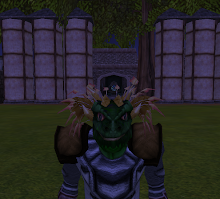What makes Istaria stand out (other than playable dragons) is the importance of crafting, both in terms of item building and community projects/player-owned plots. But like all MMOs seem to start out, the original team had a grand plan covering everything to player versus player (PvP) combat, but somewhat surprisingly – as release loomed – it was PvP that was shelved.
It's interesting to look at the pay monthly MMOs that have stuck around longest. Ultima Online (1997) was the first truly massive MMO, going over 100,000 subscribers, and has a good mix of crafting, property ownership and combat – both PvE (player versus environment, meaning the game's AI) and PvP. The same can be said of Eve from a sci-fi game perspective. Both should be applauded for squeezing it all in.
Like Istaria, Star Wars Galaxies and Ryzom also feature crafting as a truly important game mechanism. However, most other MMO stalwarts (EverQuest 1 & 2, Dark Age of Camelot, Final Fantasy, Anarchy Online, City of Heroes, World of Warcraft, Lord of the Rings Online) concentrate almost solely on combat. Sure, they all have crafting to some extent, but it could largely be withdrawn without having any serious affect on the overall outcome endgame.
Most people thought Istaria would fold, but while a string of combat orientated games perished, it hung in there. Star Wars Galaxies was hugely anticipated and an almost complete disaster. So little worked it wasn't even funny, but it's still going. Ryzom also had its problems, and a lot of people barely even noticed its arrival, but again a core of players stayed loyal. That these crafting games stayed afloat while many combat-centric ones perished is no coincidence – put simply, crafters hang around. So why hasn't someone really nailed this game mechanic?
It could be argued that games such as The Sims Online, A Tale in the Desert or even Second Life have, to a certain extent, taken chunks of this audience away. However, a great game where the emphasis was on community, combat and expansion through crafting could be a real hit.
Start at point A, which is surrounded by a hostile environment. Adventurers must keep the wildlife at bay, while crafters expand the parameters of the settlement – something akin to Harry Harrison's Deathworld books comes to mind. The larger the settlement becomes, the better technology is available, allowing for bigger and better items to be manufactured – but these need new structures and equipment to make them in, so more expansion is required. Being part of that would be amazing.
Playing a bit of Wurm Online the other day really made me wonder what could be done by a half decent dev team with a reasonable amount of cash to spend on a game that was aimed at a sizeable niche, instead of world domination. Wurm is Java based, can be played for free and looks bloody awful, but has more imagination in one of its badly rendered barrels than the recent slew of showy WoW-a-likes have in their wholly vacuous worlds.
Istaria doesn't give you the freedom Wurm does, or some of its other really hardcore sandbox aspects, but its still so far ahead of the competition in some crafting/world manipulation respects – six years after release – it's hard to believe.
Have a look at Istaria by heading to Istaria.com
You can check out Wurm Online at WurmOnline.com

No comments:
Post a Comment